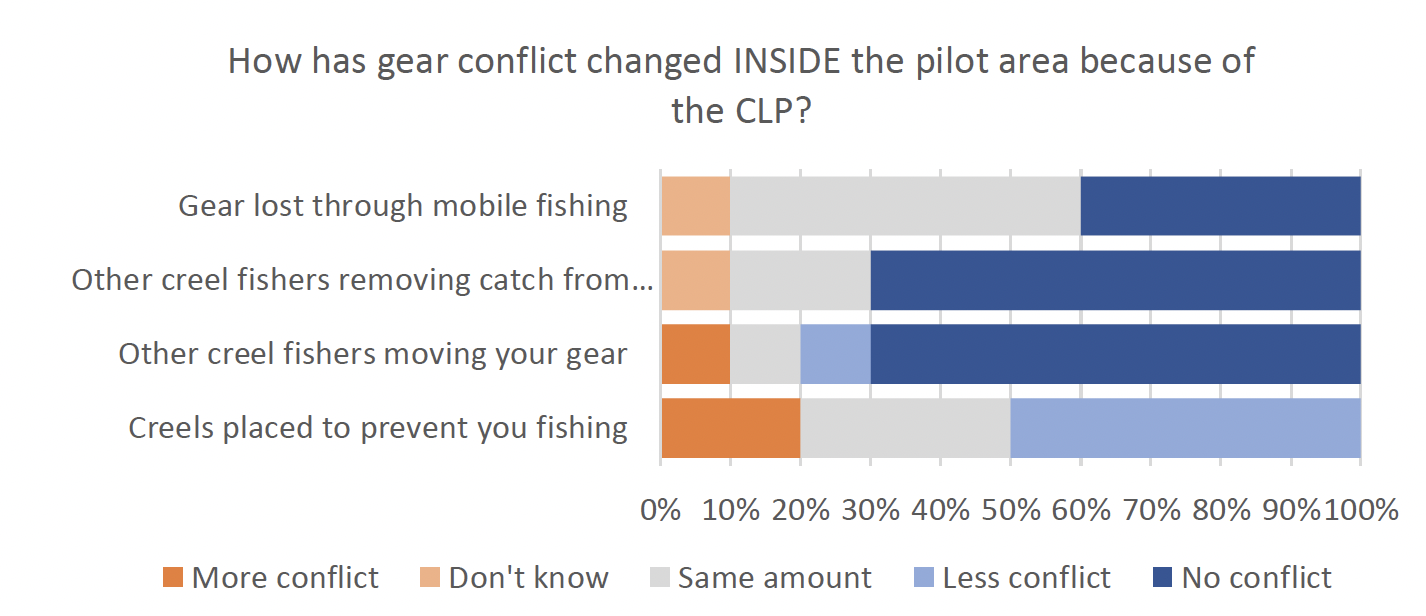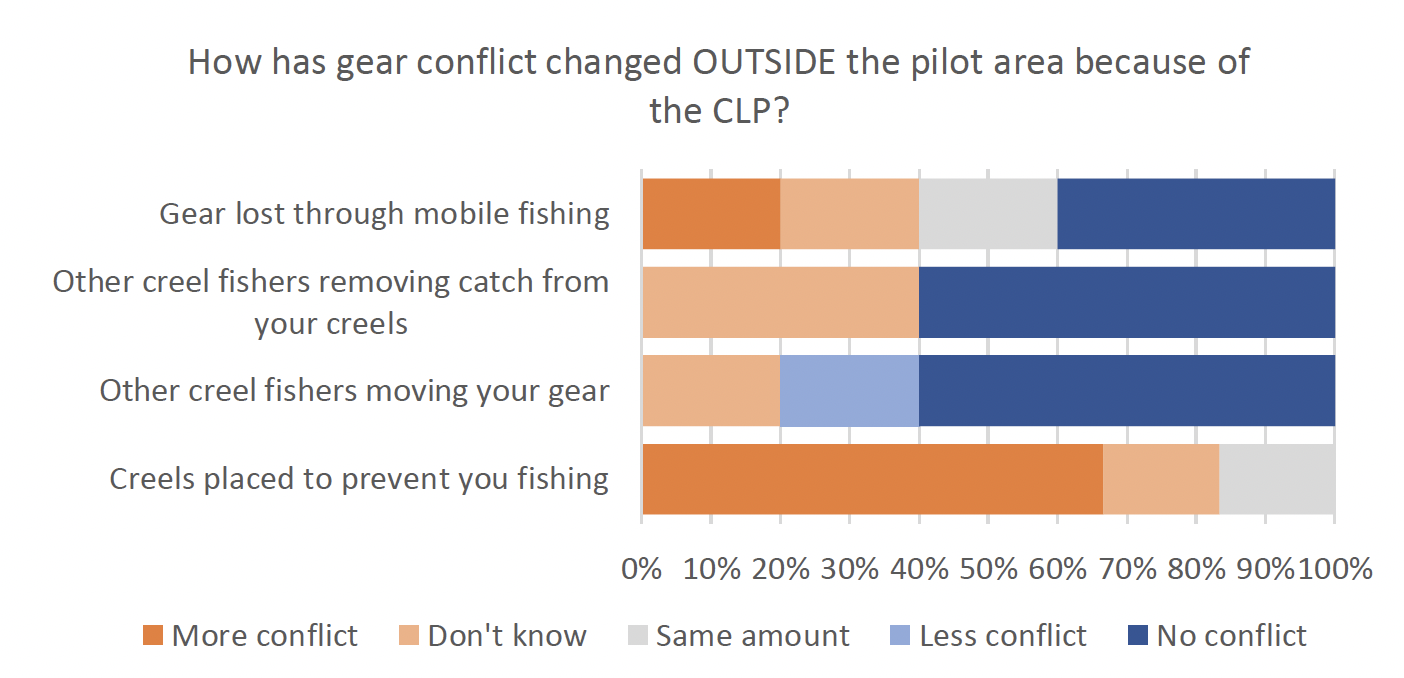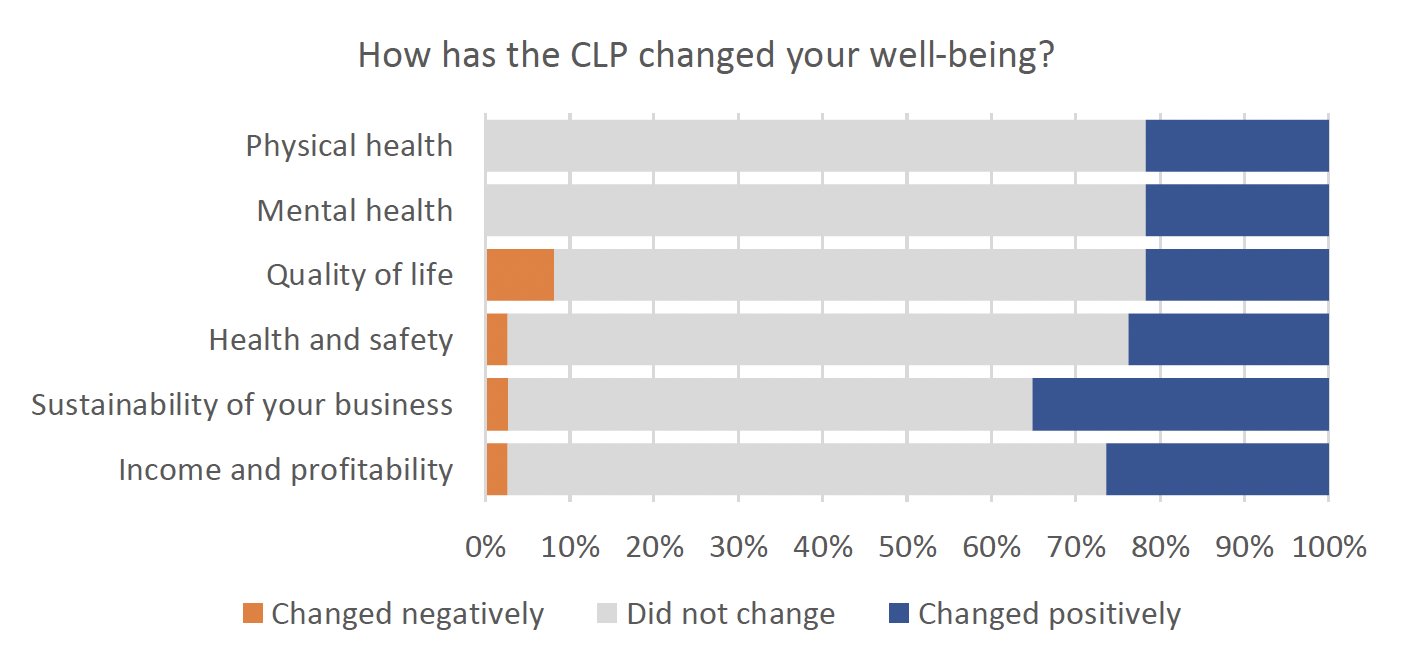Outer Hebrides creel limitation pilot: research and evaluation
Presents the findings of the survey made into the operational implications and socio-economic impacts of the Outer Hebrides Creel Limitation Pilot on fishers.
Social Implications
Key findings
- 29% of pilot participants noticed changes to gear conflict inside the pilot area and the majority of those attributed that to less creels holding fishing grounds.
- 77% of fisher said that the CLP had not affected their levels of gear conflict outside of the pilot area.
- Conflict with vivier vessels inside the pilot area appears to have been resolved by the CLP, but displacement of vivier vessels to the west of the islands is still a concern, as is the lack of regulation and what happens once the pilot project ends.
- In terms of well-being, at least 20% of survey respondents had noticed positive changes in the six well-being indices tested for, including income and profitability, business sustainability, health and safety, quality of life, mental health and physical health.
- 46% said that reducing their creel numbers would improve health and safety by reducing time at sea, fatigue and wear and tear.
This next section explains the social Implications of the CLP. Social implications include changes to gear conflict, well-being and health and safety. 'Gear conflict' involves interactions between static gear fishers, including vivier crabbing vessels, and between static and mobile gear fishers, including Nephrops trawlers and scallop dredges. 'Well-being' includes changes made to income and profitability, business sustainability, quality of life, health and safety, mental health and physical health. 'Health and safety' asks whether respondents are satisfied with their health and safety under the CLP and whether they think it could be improved if creel limits were further reduced.
Gear Conflict
Pilot Participants in the online survey reported mixed experiences in terms of gear conflict in its various forms inside the pilot area with nearly one in three (29%) reporting changes of conflict, but 68% reporting no change and 3% preferring not to say (n=34). Change in gear conflict inside the pilot area is unrelated to the number of years in which a fisher has been fishing locally (Fisher's Exact Testing: p=0.45| n=33). The perception of change in gear conflict is also seemingly unrelated to the respondent's location in the Outer Hebrides (Fisher's Exact Test: p=0.88|n=32).
Of the 29% that noticed a change, the majority (50%, n=10) said that there was less gear placed on the grounds to prevent fishing inside the pilot area (Figure 5) though 20% instead noted an increase in creels being placed on the grounds. Though this is suggestive that the CLP may be working towards reducing conflict through less holding of the grounds, the sample size is too small to conclude this definitively. In terms of the different types of conflict, it appears that it is very seldom that fishers have noticed that catch has been removed from their creels. The impact to conflict with mobile gear is unchanged with four noting no conflict, five noticing the same amount of conflict and one was unsure.

Outside the pilot area, 15% of survey participants reported changes in the levels of gear conflict (n=39). The majority of survey respondents (77%) said that the CLP has not affected their levels of gear conflict outside the pilot area and the remaining 8% chose not to say. There is no relationship between whether a change in levels of gear conflict was noticed, and the location of a fisher (Fisher's Exact Test: p=0.09| n=35). No relationship was found between perceived changes in levels of gear conflict outside the pilot area and the number of years a survey participant had been fishing locally (Fisher's Exact Test: p=0.61| n=36). In contrast, within the pilot area, the change reported by most participants was that more creels are being placed on the grounds and potentially more creels are being lost to mobile fishers, though this remains speculative due to a small sample size (Figure 6). Interviewees explained the problem in more detail:
"Creels are bought because they hold the grounds. It's like buying land; fishers buy creels and put them on their fishing grounds and then leave them for months whilst they work somewhere else. Nobody else can fish those grounds, it's their area so only they benefit."– Interviewee7
"Gear can be left lying for 3 months whilst you go and fish elsewhere and then the gear holds onto your patch. We see it most with Nephrops."– Interviewee 27

Non-participants, who are not taking part in the CLP (n=5), were also asked about their views on how gear conflict has changed, particularly between static and mobile gear fishers. Of the five non-participants, three fished static gear, one fished mobile gear and one did not say. Of the three static gear fishers, two said that they sometimes lose gear to mobile fishers, but they also said that the level of conflict has not changed as a result of the CLP. The remaining respondent felt that there was no conflict. The mobile gear fisher reported seeing the same amount of conflict inside the pilot area, but less conflict outside the pilot area. (n=1). Whilst all opinions are valid, the small sample sizes limit their utility.
Interviewees were also asked about their experiences of gear conflict and how it might have changed because of the CLP. As previously established, no relationship between gear conflict and location or years of fishing was established. Therefore, instead, data from the interviews was pooled into positive, negative and neutral sentiments. Feedback was mixed with many fishers giving both positive and negative views, so the arguments have been coded into sentiment-based themes (Table 6). Here, there was also no mention of other fishers taking catch from creels or lifting other fisher's gear.
| Sentiment | Conflict type | Code | Description | Number of interviewees |
|---|---|---|---|---|
| Positive | Static-Static | Less creels | Respondents have noticed fewer creels on their grounds. | 5 |
| Improvements with Vivier crabbers | Respondents reported that the conflict with vivier crabbing vessels has stopped inside the pilot area. | 4 | ||
| Space on the grounds | Respondents have noticed that there is more space on the grounds to shoot their creels in different places. | 3 | ||
| No holding grounds | Respondents noted conflict with other fishers in holding grounds with unused creels had stopped or reduced. | 2 | ||
| Less vessels | Respondents have noticed fewer vessels on their grounds. | 1 | ||
| Static-mobile | Less trawlers | Respondents have noticed fewer trawlers in the area, though not necessarily as a direct result of the CLP. May be to do with economics or an ageing fleet. | 3 | |
| Helped trawlers | Respondents reckoned the creel limits have been helpful for trawlers because there was less gear on the ground. | 2 | ||
| Better communication | Respondents reported better communication between mobile and static gear fishers. | 2 | ||
| Neutral | Static-static | No Issues | Respondents did not report changes in levels of gear conflict because there were no issues with creel-on-creel conflict on their grounds. | 5 |
| Conflict persists | Respondents believe conflict persists. This may be because the limits are so high that nothing has changed or because some fishers are breaking the rules. | 4 | ||
| Static-mobile | No Issues | Respondents did not report changes in the levels of gear conflict because there were no issues with mobile gear (e.g. there are no trawlers on their grounds) or fishers have a mutual understanding. | 7 | |
| Conflict persists | Respondents believe conflict with mobile gear persists. This may be because the limits are so high that nothing has changed and creels are still at risk of being entangled by mobile gear vessels. | 3 | ||
| Negative | Static-Static | More vessels West | Respondents noticed more vessels on the west coast, possibly through displacement, but could also be new entrants to the fishery. | 3 |
| More creels on the west side | Respondents had not noticed any more vessels but had noticed more creels off the west coast. | 3 | ||
| Continued issues with Vivier Crabbers | Respondents noted conflict with vivier crab vessels which are often nomadic and not registered Scottish vessels, operating thousands of creels and can work and travel in rougher seas than smaller local vessels. There is concern that they are responsible for the decline in brown crab. | 2 | ||
| Displacement | Respondents noticed that effort may have been displaced because of the CLP. | 2 | ||
| More vessels East | Respondents noticed more creeling vessels coming onto their grounds in the pilot area, bringing more creels and taking up space on the grounds. | 1 | ||
| More creels on the east side | Respondents had noticed more creels off the east coast. | 1 | ||
| Static-mobile | Trawlers inshore | Respondents noticed fishing go down when the 3nm limit was removed in the early 80s. | 1 |
In terms of relationships with mobile gear fishers, they remain largely unchanged on account of the CLP. Three pilot participants reported that they have good relationships with the mobile gear fishers and a further two said that their relationships with mobile gear fishers had improved but not necessarily because of the CLP. Improvements in communications between the two sectors had previously been made to specifically avoid conflicts. Of these five, four are from the Isles of Harris, Lewis and Scalpay.
Of the interviewees, three commented on changes to their relationships with Marine Scotland, all of whom were pilot participants (n=26). An interviewee thought their relationship with Marine Scotland had improved and a further two participants expressed a desire for Marine Scotland to do more by way of policing. There was no mention of any changes to relationships with the wider community because of the CLP, however, some fishers acknowledged that the inshore fishery around the Hebrides is crucial for the sustainability of their island communities.
Of the interview respondents, 13 also specifically mentioned their conflict with vivier crabbing vessels. The majority (seven fishers) were from Harris Lewis and Scalpay, three fishers were from the Uists and Benbecula and the remaining three were from Barra and Vatersay. Before the CLP began, respondents either experienced direct gear conflict with vivier crabbers setting their mile-long strings over the top of their own (or vice versa as floats cannot be seen a mile away) or indirect conflict over crab stock. Three interview respondents felt that the crab stocks had been "decimated" by the vivier crabbers. The pilot has helped exclude vivier vessels that fished the area before the pilot. Interviewees reported that they were either displaced to the west of the Outer Hebrides, pulled out of the industry, consolidated with other vivier vessels, or moved their creels out of the pilot area. Concern was still expressed by interviewees about the lack of regulations on vivier vessels fishing out to the west. Some of the resentment also appears to be because many of the vessels are seen to be "foreign", registered in Northern Ireland. Several fishers are concerned by the impact the vivier crabbers have on the local community.
"It's really disheartening when a large vivier boat comes in and decimates the grounds. It leaves nothing for us locals."– Interviewee 24
"They are directly impacting our future. They can go elsewhere, and they leave our small communities with nothing left."– Interviewee 3
A fisher expressed some sympathy towards the predicaments faced by vivier crabbers, believing that they have significant loans to service and are forced into more intensive fishing to make ends meet. Two respondents suggested that the decline in crab was helping to put vivier vessels out of business. Some agree that vivier vessels are less of a problem now than before the pilot began, however, they still were worried about vivier vessels coming back onto their grounds and their activities not being policed.
Well-being
Survey respondents were able to select whether they had noticed any positive or negative changes to six different indices of well-being. These included income and profitability, business sustainability, health and safety, quality of life, mental health and physical health. The large majority of survey respondents did not notice any changes for any of the well-being indices, however, positive change was noted in all 6 indices by at least 20% of survey respondents. A minority noted a negative change in income, business sustainability, health and safety and quality of life (Figure 7). The positive responses were isolated and Fisher's Exact Tests were done to determine if there was a relationship between indices of positive change and location, years of fishing or target species. There was no relationship found for either location, years fishing or target species (Fisher's Exact Test: p = 0.94, 0.79 and 1.00 respectively| n=minimum 8 and maximum 13).

Of the interview respondents, the majority also did not report any changes to their well-being. Four interviewees reported less stress and better mental health as a result of the CLP. All four fished different mixes of shellfish, however, they all had Nephrops in common. Another fisher, targeting crab and lobster hadn't noticed any changes in well-being personally, though they assumed that those targeting Nephrops would have improved well-being. A fisher who said that though their well-being was better at the time of survey, they live in fear of larger vessels coming back and decimating stocks. A respondent also commented saying that often it is the lack of ability to diversify that can negatively change well-being outcomes. If stocks begin to deplete, that can lead to poor mental health and high stress as they have no alternative target species as sources of income.
Health and Safety
Only interview respondents were asked questions about how the CLP may have impacted their health and safety. Of the interviewees, three fishers reckoned the CLP had made fishing safer because they either do not have to work as hard for the same returns or because there is less gear conflict, leading to less health and safety risk. No respondents argued that the CLP had made health and safety worse. In terms of how satisfied interviewees felt about their health and safety, the majority noted no difference in their levels of satisfaction. Four interviewees felt that they were more satisfied with their health and safety now compared to before the CLP. All four had Nephrops in their fisheries. The reasons given were less risk through less work and less time at sea, and noticeably fewer entanglements of gear.
"We always used to get entangled with other vessel's gear which is incredibly dangerous. Now it's very unusual."– Interviewee 28
No respondents said that they were less satisfied with their health and safety.
When asked if there would be a benefit to their health and safety by reducing creel numbers, twelve interviewees (46%, n=26) said that reducing creel numbers would benefit their health and safety. Of those twelve, three said that there is less personal risk through spending less time at sea. It was pointed out by five respondents that hauling fewer creels meant less physical 'wear and tear' on their bodies. A respondent valued less physical work as they find that age can make the physical side of hauling creels more challenging. Four interviewees said that having fewer creels would lead to less fatigue with two respondents highlighting that mistakes can happen when fishers get negligent or overtired.
"It's easy to become sloppy. I nearly took a creel to the face once because I wasn't paying attention at a crucial moment." – Interviewee 8
A respondent also thought that having fewer creels would improve health and safety through reduced levels of stress. Eight respondents said that they do not expect health and safety to improve because of reduced creel numbers. Since many are fishing under the limit anyway, they have not needed to alter their operational patterns in this way. Creels may also be worked differently, for example, double hauling. This would not reduce the workload despite having fewer creels. Two respondents expressed the benefits of reduced creel numbers but were pessimistic, feeling that fishers would be unwilling to take the hit of reduced creels for the sake of health and safety. No respondents thought that there would be more risk to their health and safety through reduced creel numbers.
Contact
Email: inshore@gov.scot
There is a problem
Thanks for your feedback